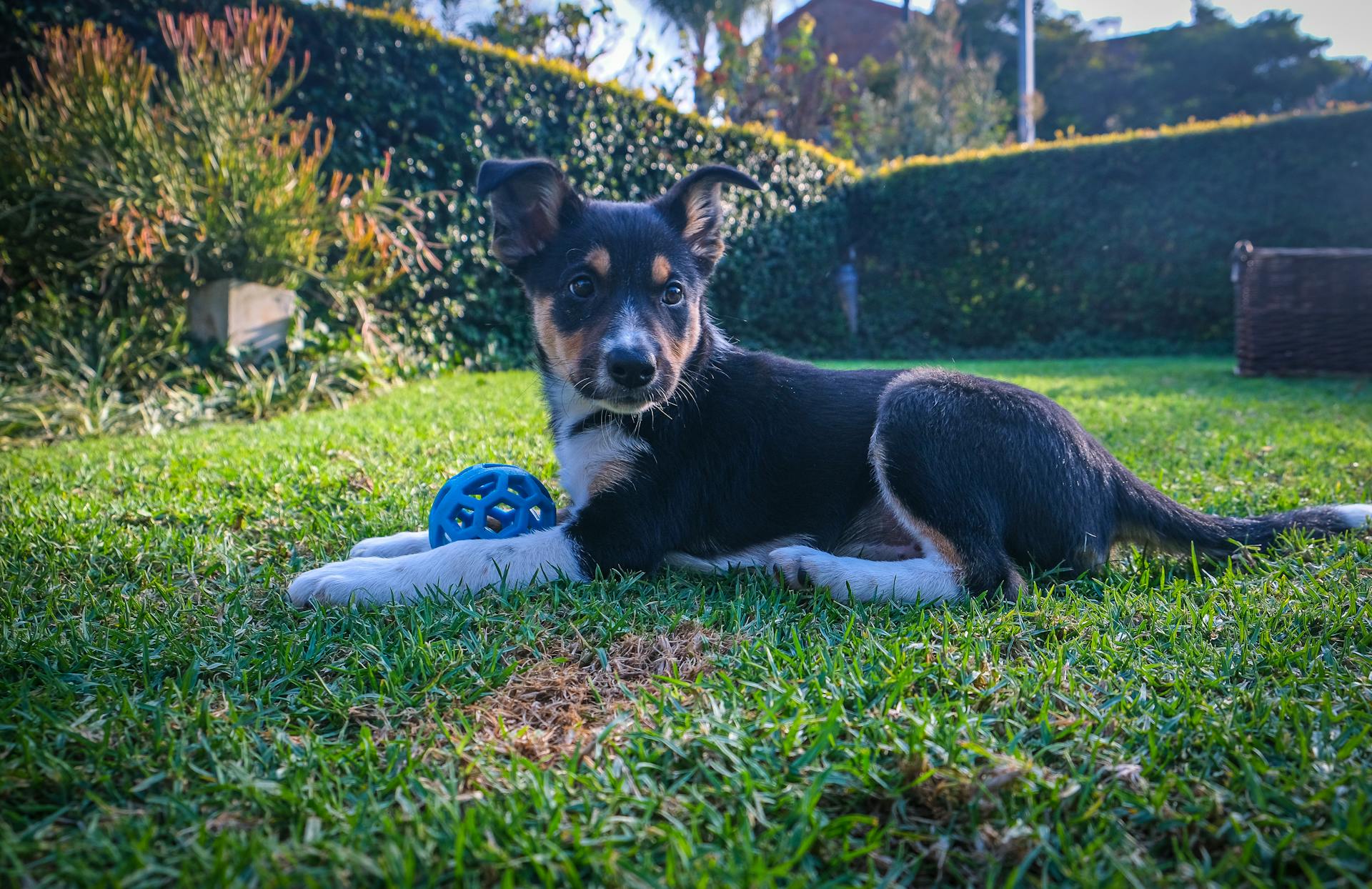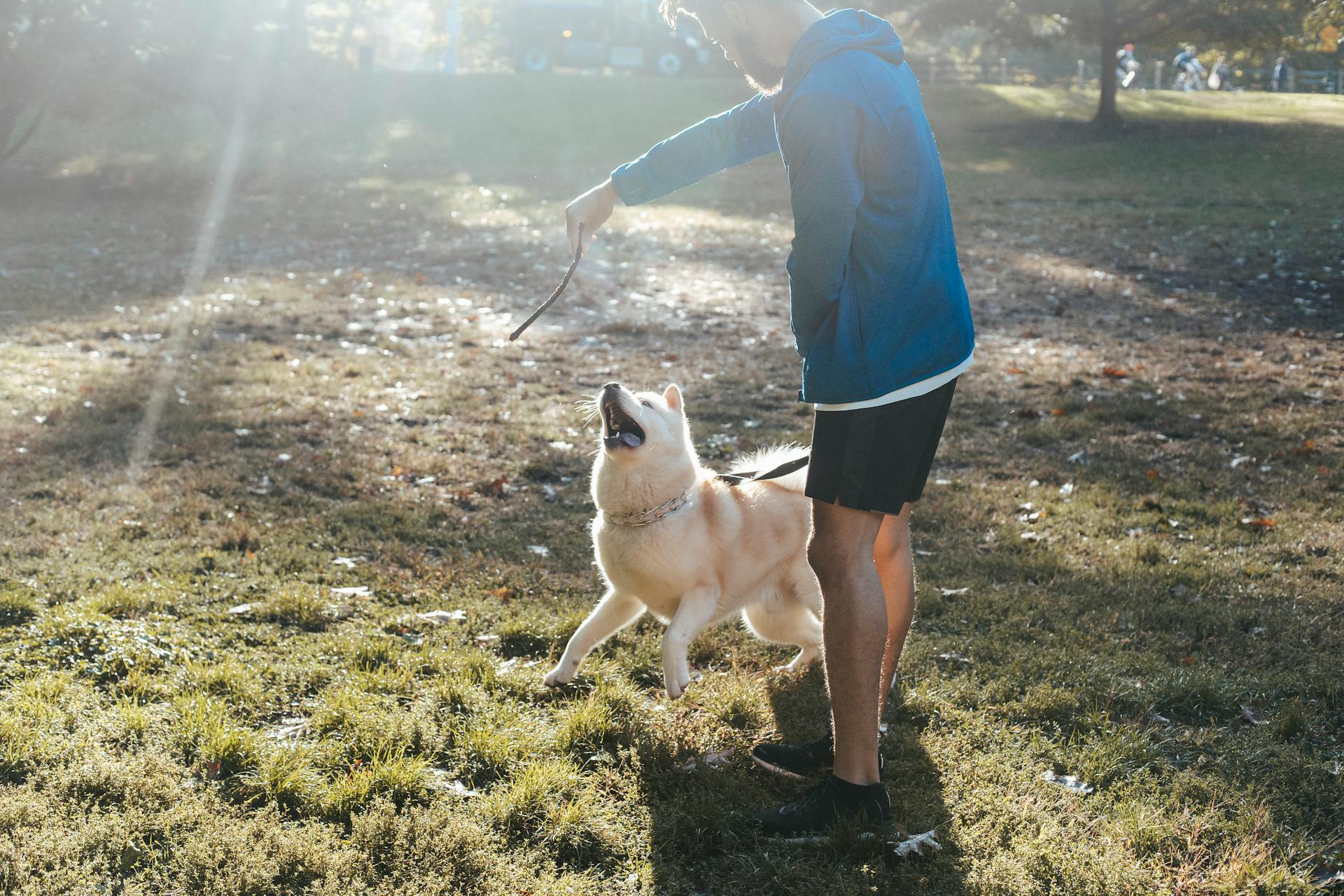
Creating a dog training basic obedience lesson plan can seem daunting, but it's easier than you think. Start by identifying your dog's age, breed, and experience level, as this will help you tailor the plan to their unique needs. A good plan should include clear goals and objectives.
Begin with short, manageable sessions of 5-10 minutes, ideally 2-3 times a day. This allows your dog to focus and learn without getting overwhelmed. Consistency is key.
As you plan, consider the five basic obedience commands: sit, stay, come, down, and walking on a leash. These commands form the foundation of a well-behaved dog.
For another approach, see: Dog Training Plan
Preparation
Before you start training your dog, it's essential to prepare them for success. Success is usually attained in small steps, after all. Training sessions with your dog should last 10 to 15 minutes, two to three times per day.
This is especially true for puppies because of their very short attention spans. Longer sessions can cause an adult dog to become bored. Start by teaching basic commands, and try to stick with one action per training session so your dog doesn't get confused.
Take a look at this: When to Start Training a Dog
Equipment
To start with, you'll need a comfortable dog collar or harness that suits your dog's needs. A flat buckle or snap collar is a good option for most dogs.
A retractable leash is not suitable for dog training, so make sure to choose a regular four-to-six-foot snap-on leash instead. This will provide more control and stability during training sessions.
You'll also need dog training treats that your dog enjoys and can eat quickly, so they can associate the reward with the desired behavior. Small pieces of plain cooked chicken or turkey can be a great option if you prefer to make your own treats.
A body harness can be a good alternative to a flat collar if you have a big, strong dog that's hard to control. This will help keep both you and your dog safe during training.
A fresh viewpoint: Why Are Dachshunds so Needy
Choose a Method
Before you start dog obedience training, it's essential to choose the right method for you and your dog. Positive reinforcement, such as praise or treats, is a great way to get started.
Most trainers agree that dogs respond best to positive reinforcement.
You can learn about various training techniques and find the best fit for you and your dog by checking out dog training books and websites.
Don't forget to include socialization in your training plan.
Expand your knowledge: Positive Reinforcement Dog Training
Lesson Plan Structure
To create a solid foundation for your dog training basic obedience lesson plan, it's essential to have a clear structure in place. A successful lesson plan starts with having clearly defined goals in mind.
Having a clear understanding of how you'll structure your class is crucial, as this will make it easier for participants to understand what's expected of them throughout each session. Importantly, these sections should be clearly-defined and easy-to-follow.
When designing a lesson plan for individual versus group classes, it's essential to consider the differences between the two. Although they share many similarities, there are some key differences to be aware of, such as how participants will interact and how knowledge will be assessed.
Here's a quick rundown of what to consider when structuring your dog training basic obedience lesson plan:
- Will you offer one-on-one sessions, group classes, or both?
- What are the objectives you want to accomplish throughout the class?
- How will participants interact?
- In what ways will knowledge be assessed?
- How much time do you have available per session?
What is Structure?
Structure is the backbone of any successful training plan. It's about providing clear boundaries and expectations for your pup.
Clear expectations are key to helping your pup understand what behaviors are acceptable and which ones aren't. This helps them learn and grow at their own pace.
Providing positive reinforcement when your pup obeys commands or displays good behavior is a crucial part of structure. This encourages their learning process and strengthens your bond.
Breaking up each command into small, manageable steps is also important for structure. This helps your pup stay focused and motivated throughout the learning process.
The 4 Stages of Learning
Understanding the 4 stages of learning is crucial when creating a lesson plan for your dog training sessions. These stages are essential for your pup to grasp new skills and behaviors.
Acquiring knowledge and understanding is the first stage, where your pup learns the basics of a new command. This stage is all about laying the groundwork for future learning.
Practicing new skills is the second stage, where your pup gets to put their knowledge into action. This stage is where repetition and practice come into play.
On a similar theme: Dog Training Stages
Consolidating the skills learned is the third stage, where your pup solidifies their understanding of a new command. This stage requires patience and consistency from you, the trainer.
Mastering the learned behavior is the fourth and final stage, where your pup becomes proficient in the new skill. This stage requires time, patience, and repetition, but the end result is well worth it.
Here's a brief overview of the 4 stages of learning in dog training:
Remember, each stage requires time, patience, and repetition. With a little time and a lot of love, your pup will soon become a pro in no time.
Basic Obedience
To start with, the sit command is often one of the easiest for your dog to learn first. This is a great foundation for more advanced commands.
You should train your dog to lie down and stay at the same time as the sit command. This will help you establish a routine and make training more efficient.
Teaching your dog to come when called is one of the most important fundamental commands. It's essential to train your dog to respond to this command as soon as possible.
Before you start the training program, it's essential to read the Week 1 lesson plan, including the "Introduction to dog training." This will give you some useful background and explain the theory behind the training.
To get the best results, train your dog at least 30 minutes each day, ideally in two 15-minute sessions. This will help your dog stay focused and retain the information.
Be patient with your dog and yourself as you go through the training process. It's a learning curve for both of you, and it's essential to take it one step at a time.
Discover more: It's Your Choice Dog Training
Is For All
Dogs learn at their own pace, so it's essential to tailor your training sessions to their unique needs. Some dogs pick up new commands quickly, while others may need more time.
A general rule of thumb is to spend a few minutes each day training your pup to prevent them from forgetting what they've learned. Consistency is key.
The seven most common commands to train your pup are sit, stay, lie down, come, heel, off, and leave it. These commands should be accompanied by plenty of positive reinforcement for effective learning.
Positive reinforcement is a powerful tool in dog training. Rewarding your dog with food treats, praise, and affection can help them associate good behavior with positive outcomes.
A quiet dog is often overlooked, but it's precisely this time that you should be praising them. By ignoring bad behavior and rewarding good behavior, you can encourage your dog to learn and grow.
Here is a list of the 7 most common commands to train your pup:
- Sit
- Stay
ComeHeelOffLeave it
How to Design a Lesson Plan
To design a lesson plan for your dog training basic obedience lesson plan, start by asking yourself some key questions. What are the objectives you want to accomplish throughout the class? Having clearly defined goals in mind will make it easier to create a lesson plan tailored to the needs of your students.
Discover more: Dog Training Business Plan
Consider how you'll offer training sessions – will it be one-on-one, group classes, or both? This will help you tailor the activities to meet specific needs or skill levels. Think about how activities can be adapted for one-on-one sessions versus group classes.
You should also plan for enough practice time to ensure that your clients can apply the skills learned during class once they're back at home with their pup. This means breaking up each command into small, manageable steps and providing plenty of practice time, positive reinforcement, and clear expectations during each stage of learning.
Before getting started, ask yourself:
- Do you intend to offer one-on-one sessions, group classes, or both?
- What are the objectives you want to accomplish throughout the class?
- How will participants interact?
- In what ways will knowledge be assessed?
- How much time do you have available per session?
These questions will help you create a solid foundation for your lesson plan, ensuring it meets the needs of your students and sets them up for success.
Class Management
Class Management is crucial for a successful dog training class. Clearly-defined sections make it easy for participants to understand what's expected of them throughout each session.
Expand your knowledge: Master Class Dog Training
It's essential to pace the training to avoid overwhelming the dog and handler. An eight-week course outline is a great starting point, allowing youth to keep up without feeling too much pressure.
Adjusting the pace for quick learners and the age of the audience is also vital. This ensures patience is present for both the dog and handler, preventing discouragement.
Choosing an Instructor
Choosing an Instructor is crucial for a successful training experience. Observe a class or two to see if the style of instruction fits with your beliefs, and leave your pup at home for this.
Most dogs learn best through positive reinforcement training, which rewards the dog for making the right choice. This approach helps create a happy and relaxed environment for your dog.
Take note of the dogs in the class; do they look happy, relaxed, and excited to work? A good instructor will encourage both dogs and owners.
See what others are reading: Do Rottweilers Growl When Happy
Types of Classes
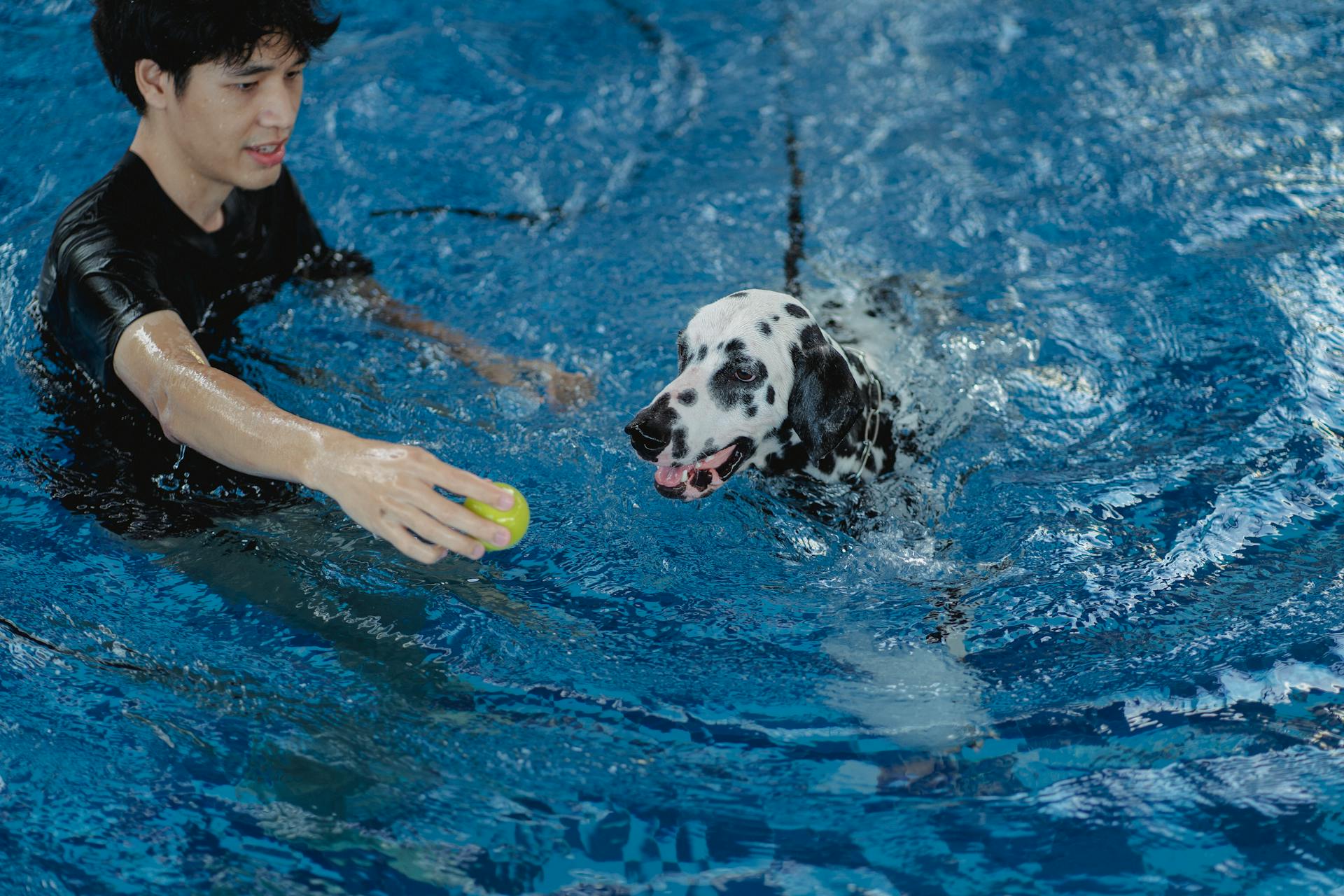
Most schools have a series of puppy classes, starting for puppies as young as eight weeks, and training can progress through various levels.
These classes can help your puppy develop good behavior and strengthen your bond with them. Puppies and owners who complete at least six weeks of class can earn the AKC STAR Puppy certification.
The AKC STAR Puppy certification is a great achievement, but if you're looking for a more rigorous training program, you might consider the AKC Canine Good Citizen certification, which shows that your dog has obedience training and is under control around other people and dogs.
Dog sports classes, such as agility, AKC Rally, tricks, and Flyball, are also available for more advanced training. These classes can be a fun way to challenge your dog and help them develop new skills.
Take a look at this: Akc Dog Training Certification
Class Structure
Clearly-defined sections are a must for a well-structured dog training class. This ensures participants understand what's expected of them throughout each session.
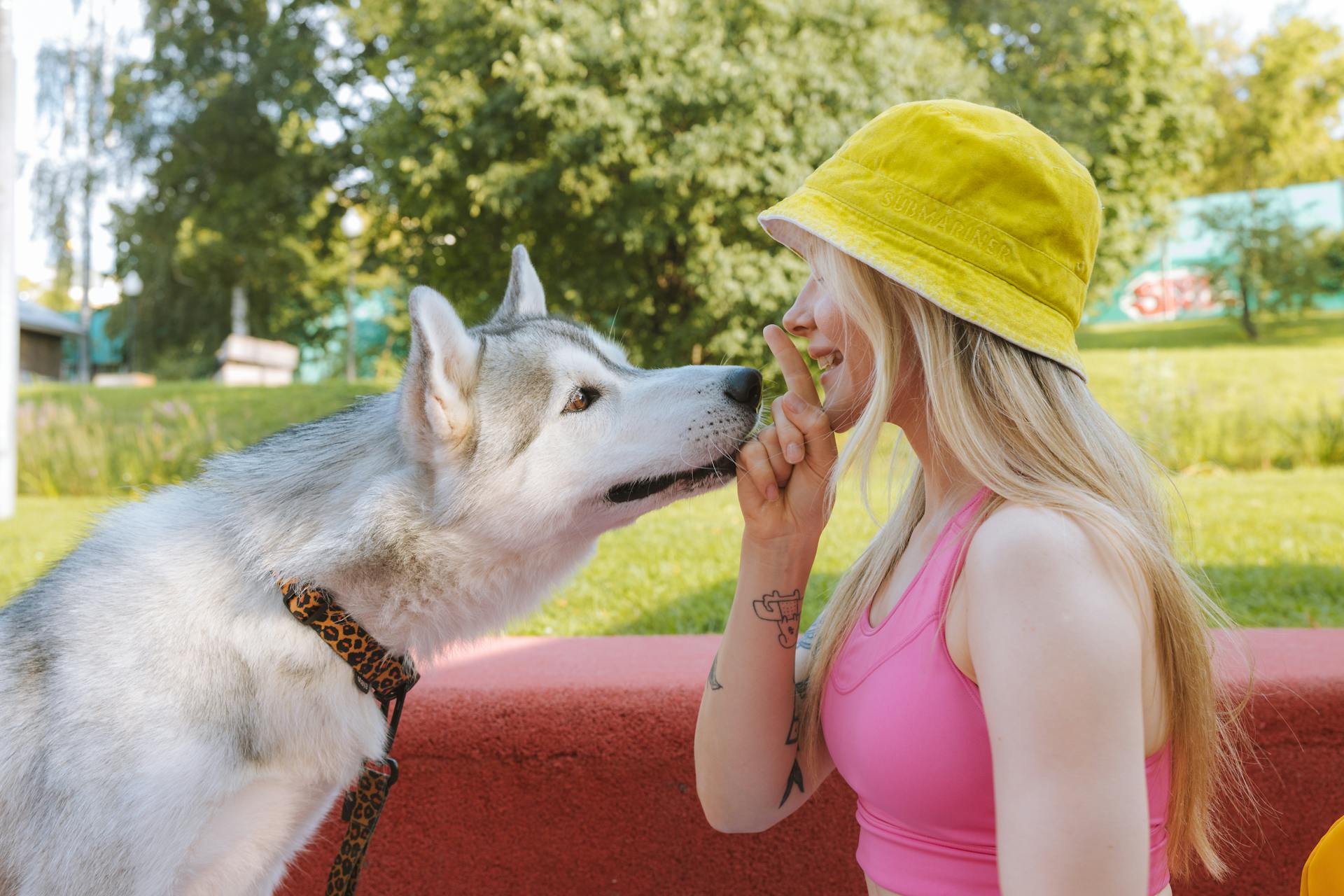
Importantly, these sections should be easy to follow. This helps participants stay on track and get the most out of the class.
A leader can teach the basics in an eight-week course. This pace allows youth to keep up without feeling overwhelmed, and the dogs can perfect a move before moving on to the next.
Teaching too much information at once can be counterproductive. It's better to move at a pace that's right for the dog and the handler.
A good rule of thumb is to adjust for quick learners and for the age of your audience. This ensures everyone stays engaged and has fun.
Assessing training progress is crucial to any dog training lesson plan. This helps you accurately tell how well a dog is doing and identify any necessary changes in your curriculum.
Including an assessment component at the end of each session is a must. This can be done through testing, observation, or any other methods that help you evaluate a dog's performance.
Recognize Common Problems
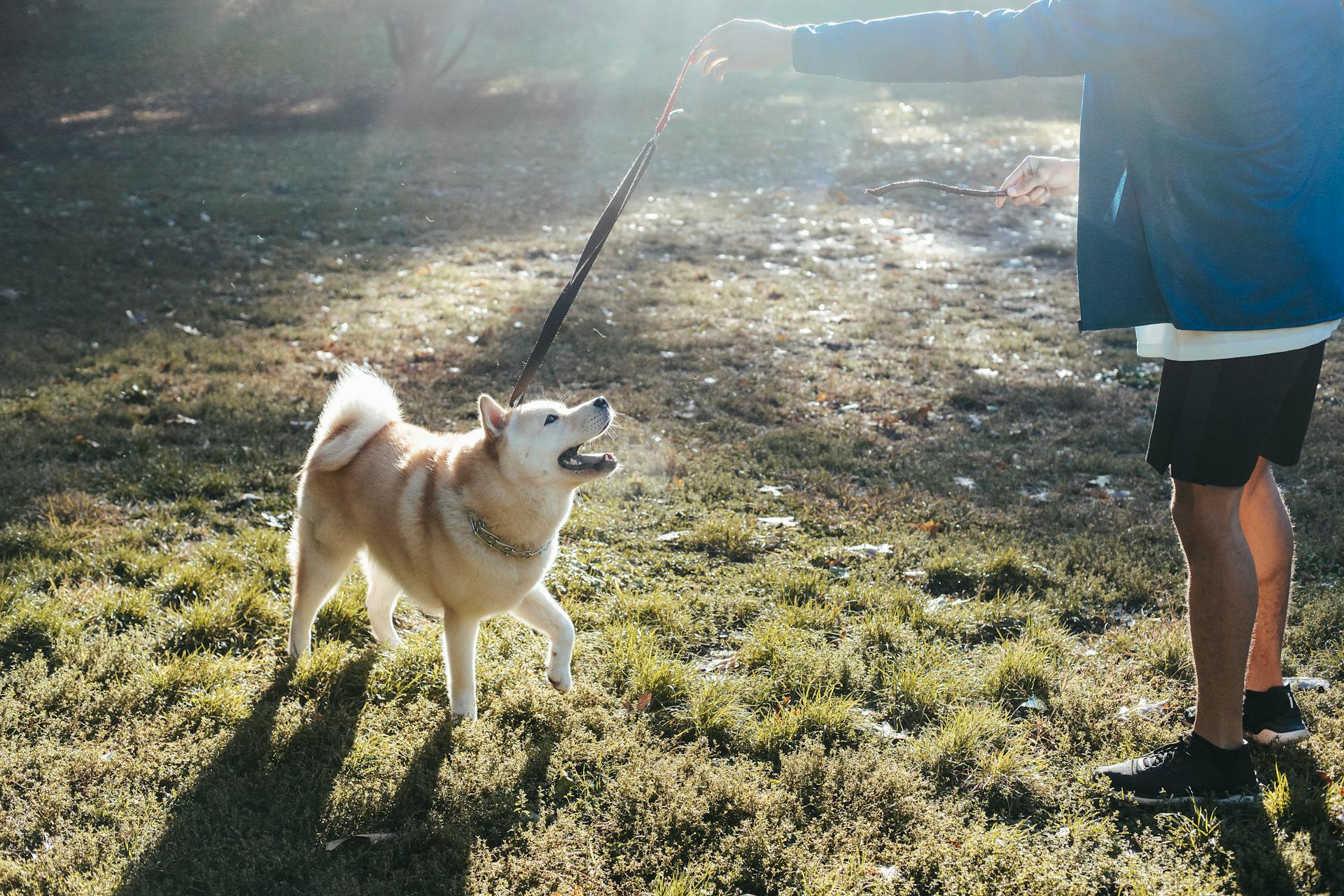
You must first teach your students what is acceptable in a classroom setting, just like teaching a dog what is acceptable in the human world.
Teaching older students can be a challenge, but it's not impossible. Older dogs can learn too, and so can older students with the right approach.
In a classroom, common problems can arise if students don't know what's expected of them. If you want your students to live successfully in a classroom, you must first teach them what is acceptable.
Classroom management is easiest done with a plan, just like training a puppy is easiest done with positive reinforcement.
Worth a look: Pad Training an Older Dog
Frequently Asked Questions
What are the six basic commands for dog training?
The six basic commands for dog training are "Come", "Sit", "Stay", "No", "Down", and "Leave it". Mastering these commands is the first step to shaping a well-behaved and loyal canine companion.
What is the first thing you should train your puppy?
Train your puppy with the sit command first, as it's one of the easiest and most essential skills to teach. Mastering the sit command is a great starting point for successful puppy training.
How old should a puppy be to start basic training?
Typically, puppies can start basic training at 8 weeks old, learning essential cues like sit, stay, and come. Early training sets the foundation for a well-behaved and well-adjusted adult dog
What are the basics of puppy training?
The basics of puppy training involve teaching fundamental commands like "Sit," "Come," and "Stay" to establish a strong bond and lay the groundwork for advanced training. Mastering these essential commands sets the foundation for a well-behaved and well-adjusted puppy.
Sources
- https://www.thesprucepets.com/start-dog-obedience-training-program-1118245
- https://www.akc.org/expert-advice/training/basic-obedience-training-for-your-dog/
- https://www.slideshare.net/slideshow/dog-training-book-59026955/59026955
- https://blog.qcpetstudies.com/blog/2023/01/how-to-design-a-dog-training-lesson-plan/
- https://www.canr.msu.edu/news/dog_training_how_to_structure_a_beginners_obedience_class
Featured Images: pexels.com
